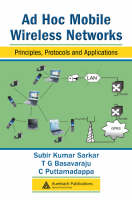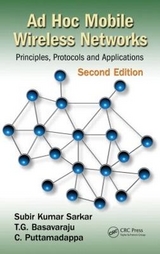
Ad Hoc Mobile Wireless Networks
Auerbach (Verlag)
978-1-4200-6221-2 (ISBN)
- Titel erscheint in neuer Auflage
- Artikel merken
Ad hoc mobile wireless networks have seen increased adaptation in a variety of disciplines because they can be deployed with simple infrastructures and virtually no central administration. In particular, the development of ad hoc wireless and sensor networks provides tremendous opportunities in areas including disaster recovery, defense, health care, and industrial environments. Ad Hoc Mobile Wireless Networks: Principles, Protocols and Applications explains the concepts, mechanisms, design, and performance of these systems. It presents in-depth explanations of the latest wireless technologies, including Bluetooth, IrDA, HomeRF, WiFi, WiMAx, wireless Internet, and the mobile IP.
The book begins with a focus on ad hoc wireless networks and MAC protocols, discussing the issues of collision resolution, multiple channels, and the use of directional antennas. It continues with a preview of the numerous practical applications of mobile ad hoc networks (MANETs) and describes how these applications involve different scenarios dependent on the environment and nature of participant interactions. The authors address the trials of bringing Quality of Service (QoS) support to MANETs and the common difficulties associated with that task, which include mobility, limited bandwidth, and power consumption. Every chapter provides relevant examples and problems to illustrate each concept.
Communication between various devices makes it possible to provide unique and innovative services. Although ad hoc systems are very powerful mechanisms, they are also quite complex. This masterful resource demystifies these complexities with detailed accounts of the technologies, applications, and challenges related to this influential technology.
Jadavpur University, Calcutta, India Sapthagiri College of Eng, Bangalore-57, India Manipal Instit of Technology, India
INTRODUCTION
Fundamentals of Wireless Networks
Wireless Internet
What Are Ad Hoc Networks?
MAC LAYER PROTOCOLS FOR AD HOC WIRELESS NETWORKS
Introduction
Important Issues and Need for Mac Protocols
Classification of Mac Protocols
ROUTING PROTOCOLS FOR AD HOC WIRELESS NETWORKS
Introduction
Design Issues of Routing Protocol for Ad Hoc Networks
Classification of Routing Protocols
Proactive Routing Protocols
Reactive Routing Protocols
Hybrid Routing Protocols
MULTICAST ROUTING PROTOCOLS FOR MOBILE AD HOC NETWORKS
Introduction
Issues in Designing a Multicast Routing Protocol
Classification of Multicast Routing Protocols
Multicast Ad Hoc on Demand Distance Vector Protocol
Mesh Based Routing Protocols
Source Routing Multicast Protocol
Multicasting with Quality of Service Guarantees
Energy Efficient Multicast Routing Protocols
Application Dependent Multicast Routing
TRANSPORT PROTOCOLS FOR AD HOC NETWORKS
Introduction
Tcp's Challenges and Design Issues in Ad Hoc Networks
Tcp Performance over Manets
Adhoc Transport Protocols
Application Controlled Transport Protocol (Actp)
QUALITY OF SERVICE AD HOC NETWORKS
Introduction to Qos
Issues and Challenges Involved In Providing Qos
Classification of Qos Solutions
ENERGY MANAGEMENT SYSTEM IN AD HOC WIRELESS NETWORKS
Introduction
Energy Efficient Routing Protocol
Transmission Power Management Schemes
Transmission Power Control
Aodv Protocol
Local Energy-Aware Routing Based On Aodv (Learaodv)
Power-Aware Routing Based On Aodv (Par-Aodv)
Lifetime Prediction Routing Based On Aodv (Lpr-Aodv)
MOBILITY MODELS FOR MULTI HOP WIRELESS NETWORKS
Introduction
Mobility Models
Mobility Patterns
Mobility Models for Mobile Ad Hoc Networks
CROSS LAYER DESIGN ISSUES FOR AD HOC WIRELESS NETWORKS
Introduction
Cross Layer Design Principle
Proposals Involving Cross Layer Design
Cross Layer Design: Is It Worth Applying It?
Cross-Layer Design in Wireless Networks
Performance Objectives
Pitfalls of the Cross-Layer Design Approach
APPLICATIONS AND RECENT DEVELOPMENTS IN AD HOC NETWORKS
Introduction
Typical Applications
Applications and Opportunities
Challenges
Highlights the Most Recent Developments in the Field
Each chapter contains a summary
| Erscheint lt. Verlag | 5.11.2007 |
|---|---|
| Zusatzinfo | 17 equations; 4 Tables, black and white; 85 Illustrations, black and white |
| Verlagsort | London |
| Sprache | englisch |
| Maße | 156 x 235 mm |
| Gewicht | 612 g |
| Themenwelt | Technik ► Nachrichtentechnik |
| ISBN-10 | 1-4200-6221-2 / 1420062212 |
| ISBN-13 | 978-1-4200-6221-2 / 9781420062212 |
| Zustand | Neuware |
| Haben Sie eine Frage zum Produkt? |
aus dem Bereich


